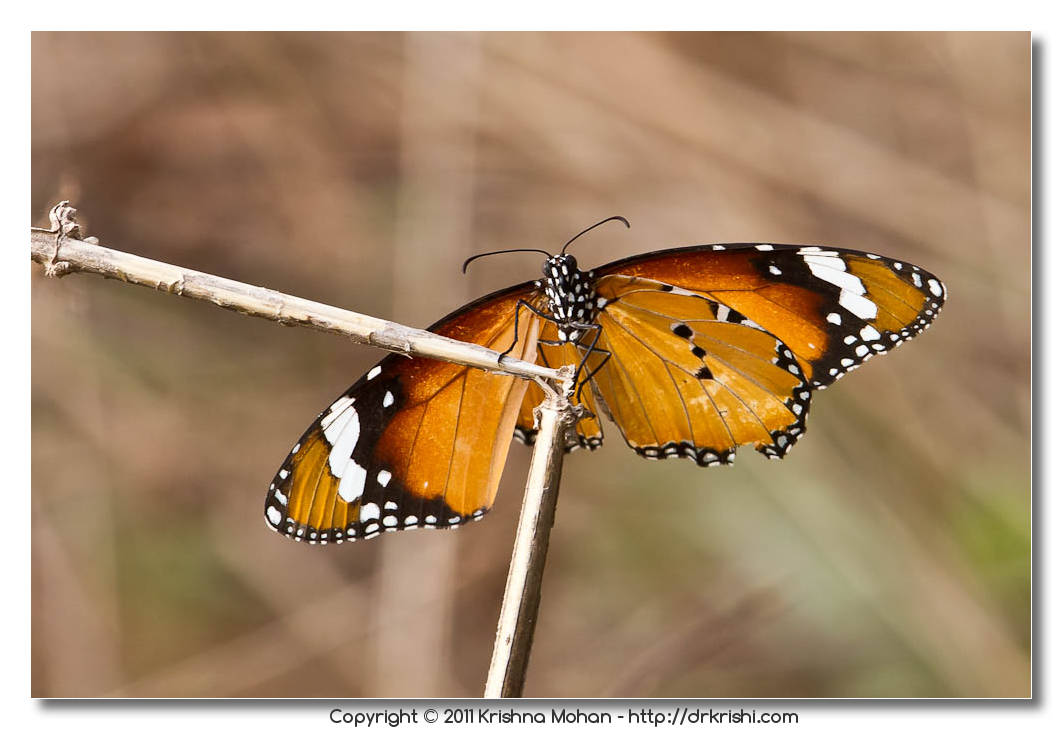
I had written long back on Plain tiger (Danaus chrysippus) butterfly. At that time I was using Canon EF 400mm f/5.6 L USM with 36mm of extension tube to photograph this Plain Tiger butterfly. Soon after the Scarlet Skimmer dragonfly photograph session which I published last week, I spotted a female plain tiger butterfly nearby. I used the same setup as I used in the dragonfly photography. My rig consisted of 1D Mark IV camera with Canon EF 300mm f/2.8L + 1.4x tele-converter stabilized on a monopod. Beautiful evening sun gave me plenty of golden light to experiment around this butterfly. It was not at all shy in posing for me as was evident in the photos which is one of the great advantages of using a long telephoto lens for closeup shoots.

As I photographed I noticed that the butterfly had a wound on the thorax at the base of the right hind-wing. The Plain Tiger is protected from attacks due to the unpalatable alkaloids ingested during the larval stages. The larvae pf this butterfly feed on host plants like milkweeds (like Asclepias, Calotropis) which are have toxic alkaloids. The butterfly therefore flies slowly and leisurely, generally close to the ground and in a straight line. This gives a would-be predator ample time to recognize and avoid attacking it. Inexperienced predators will try attacking it, but will learn soon enough to avoid this butterfly as the alkaloids in its body cause vomiting. The butterfly I was photographing also must have escaped such an attack on it.

It was an old wound, the lymph had accumulated and clotted around the right side of the thorax. Even though injured the butterfly was flying normally and was resting like any other of its kind. Tenacity of this butterfly was amazing. The butterfly also has a tough, leathery skin to survive such occasional attacks. When attacked it fakes death and oozes nauseating liquid which makes it smell and taste terrible. This encourages the predator to release the butterfly quickly. The Plain Tiger thus has the ability to recover “miraculously” from predator attacks that would kill most other butterflies.

Even though a macro lens and a flash setup is ideal to get extremely closeup photos of these butterflies, my tele-macro setup works nice. Drawback of this setup is that it needs a good light and is heavy and cumbersome. So it is not very portable. With that setup I can take quite a good amount of closeup shots with a very creamy bokeh effect. I can also using the same setup photograph birds and other distant object which is a real bonus as the same rig works as dual purpose setup.



very informative posts. i reached here searching for info abt a dragon fly (scarlet skimmer) and loved most of ur pics and articles. thnx for sharing the info and these beautiful pics.
Thank you Sandeep. Hope my blog will be useful to you in future too. Keep visiting.
Excellent series, love the color, contrast & sharpness.
Excellent Sir, much more information with snaps of different angles, which is not so easy to get… congrats.!